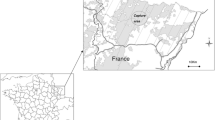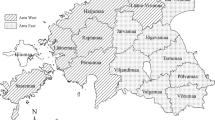Abstract
Oral immunisation of wild boar against classical swine fever (CSF) in the German federal state of Baden-Württemberg has been evaluated on the basis of the seroprevalence rates after application of an improved immunisation procedure consisting of three double vaccinations per year (in spring, summer and autumn). The seroprevalence in the vaccination area increased continuously until the third immunisation campaign (72.4% seropositive animals). Later, a decrease of the seroprevalence rates was detected, especially in young boars. Although in the infected area the seroprevalences were higher, in principle, the same trend could be found in the surveillance zone. The development of the monthly seroprevalence rates of young boars during the first year of their life showed that the new immunisation procedure had a positive effect on their immunisation rate. Fifty percent and more of the wild boar shot at the age of 6–12 months were antibody positive. Neutralising antibody titre levels were the same in young boars (on average 812 ND50) and in sub-adults (on average 997 ND50). Individual antibody positive animals may be detected for more than 2 years after completion of the vaccination programme.





Similar content being viewed by others
References
Anonymous (1980) Council Directive 80/217/EEC, introducing Community measures for the control of classical swine fever. Offic J Euro Commun L47:11–23
Anonymous (2001) Council Directive 2001/89/EC on Community measures for the control of classical swine fever, 23 October 2001. Offic J Eur Commun L316:5–35
Depner K, Müller T, Lange E, Staubach CH, Teuffert J (2000) Transient classical swine fever virus infection in wild boar piglets partially protected by maternal antibodies. Dtsch tierärztl Wschr 107:66–68
Floegel-Niesmann G, Bunzenthal C, Fischer S, Moennig V (2003) Virulence of recent and former classical swine fever virus isolates evaluated by their clinical and pathological signs. J Vet Med B 50:214–220
Kaden V, Lange E (1998) Vaccination as strategy of CSF control in wild boar. In: Measures to control classical swine fever in European Wild Boar. Perugia, Italy, 6–7 April, pp 110–114
Kaden V, Lange B (2001) Oral immunisation against classical swine fever (CSF): onset and duration of immunity. Vet Microbiol 82:301–310
Kaden V, Lange E (2004) Development of maternal antibodies after oral vaccination of young female wild boar against classical swine fever. Vet Microbiol 103:115–119
Kaden V, Lange E, Fischer U, Schurig U, Hillmann K-H, Bauer L, Kiupel H, Dedek J, Wolf P, Krey M, Kranz R (1995) State of the art of oral vaccination of wild boar against CSF in Germany. Report on Annual Meeting of National Swine Fever Laboratories, Valdeolmos, Madrid, Spain, European Commission, doc VI/1779/96 JMW/vb, pp 23–25
Kaden V, Lange E, Steyer H (1999a) Orale Immunisierung gegen Klassische Schweinepest beim Schwarzwild: Bewertung maternaler Antikörper. Amtstierärztl Dienst Lebensmittelkontrolle 6:302–305
Kaden V, Steyer H, Strebelow G, Lange E, Hübert P, Steinhagen P (1999b) Detection of low virulent classical swine fever virus in blood of experimentally infected animals. Comparison of different methods. Acta Virol 43:373–380
Kaden V, Lange E, Fischer U, Strebelow G (2000a) Oral immunisation of wild boar against classical swine fever: evaluation of the first field study in Germany. Vet Microbiol 73:239–252
Kaden V, Ziegler U, Lange E, Dedek J (2000b) Classical swine fever virus: clinical, virological, serological and haematological findings after infection of domestic pigs and wild boars with the field isolate “Spante” originating from wild boar. Berlin Münch Tierärztl Wschr 113:412–416
Kaden V, Heyne H, Kiupel H, Letz W, Kern B, Lemmer U, Gossger K, Rothe A, Böhme H, Tyrpe P (2002) Oral immunisation of wild boar against classical swine fever: concluding analysis of the recent field trials in Germany. Berl Münch Tierärztl Wschr 115:179–185
Kaden V, Renner CH, Rothe A, Lange E, Hänel A, Gossger K (2003) Evaluation of the oral immunisation of wild boar against classical swine fever in Baden-Württemberg. Berlin Münch Tierärztl Wschr 116:362–367
Kaden V, Lange E, Steyer H (2004) Does multiple oral vaccination of wild boar against classical swine fever (CSF) have a positive influence on the immunity? Dtsch tierärztl Wschr 111:63–67
Kern B (1998) Experiences with CSF-Vaccination of wild boar in Brandenburg. In: Measures to control classical swine fever in European Wild Boar. Perugia, Italy, 6–7 April, pp 122–127
Kern B, Lahrmann KH (2000) Orale Immunisierung gegen klassische Schweinepest (KSP) beim Schwarzwild in Brandenburg 1995 bis 1997. Dtsch tierärztl Wschr 107:469–544
Kiupel H, Dedek J, Heyne H (1998) Oral immunisation of wild boars in Western Pomerania against Classical Swine Fever (CSF), using aerial distribution of baits. In: Measures to control classical swine fever in European Wild Boar. Perugia, Italy, 6–7 April, pp 116–121
Knopf A, Lange E, Kaden V (2002) In vivo and in vitro characterisation of different CSFV field isolates originating from wild boar: first results. In: Fifth Pestivirus Symposium, 26th −29th August 2002, St. John’s College, Cambridge, UK, p 77
Liess B (1987) Pathogenesis and epidemiology of hog cholera. Ann Rech Vét 18:139–145
Moennig V, Plagemann GW (1992) The pestiviruses. Adv Virus Res 42:53–98
Van Oirschot JT (1988) Description of the virus infection. In: Liess B (ed) Classical swine fever and related viral infections. Martinus Nijhoff Publishing, Boston, pp 1–25
Acknowledgements
We thank all colleagues and hunters involved in the performance, diagnosis and evaluation of oral immunisation. Furthermore, we thank Heidemarie Möller, Silke Vogt (Fellbach) and Brigitte Dannenfeld (Insel Riems) for their excellent technical assistance and Anette Beidler for critical reading of the manuscript.
Author information
Authors and Affiliations
Corresponding author
Rights and permissions
About this article
Cite this article
Kaden, V., Hänel, A., Renner, C. et al. Oral immunisation of wild boar against classical swine fever in Baden-Württemberg: development of the seroprevalences based on the hunting bag. Eur J Wildl Res 51, 101–107 (2005). https://doi.org/10.1007/s10344-005-0083-2
Received:
Accepted:
Published:
Issue Date:
DOI: https://doi.org/10.1007/s10344-005-0083-2




